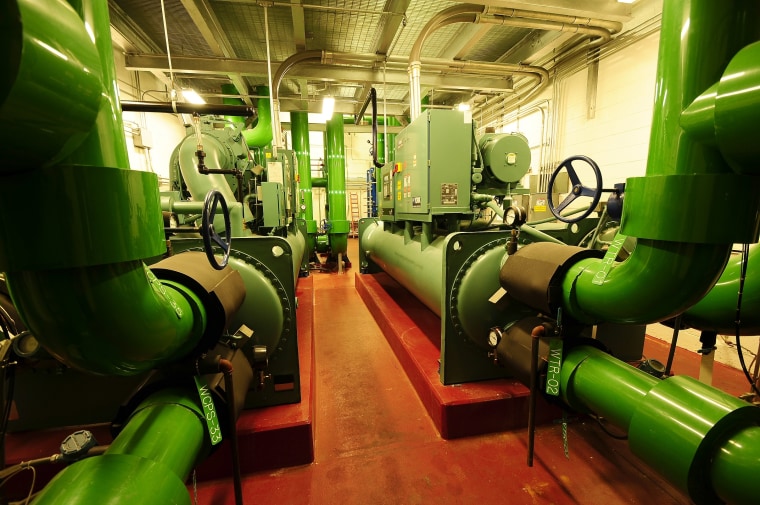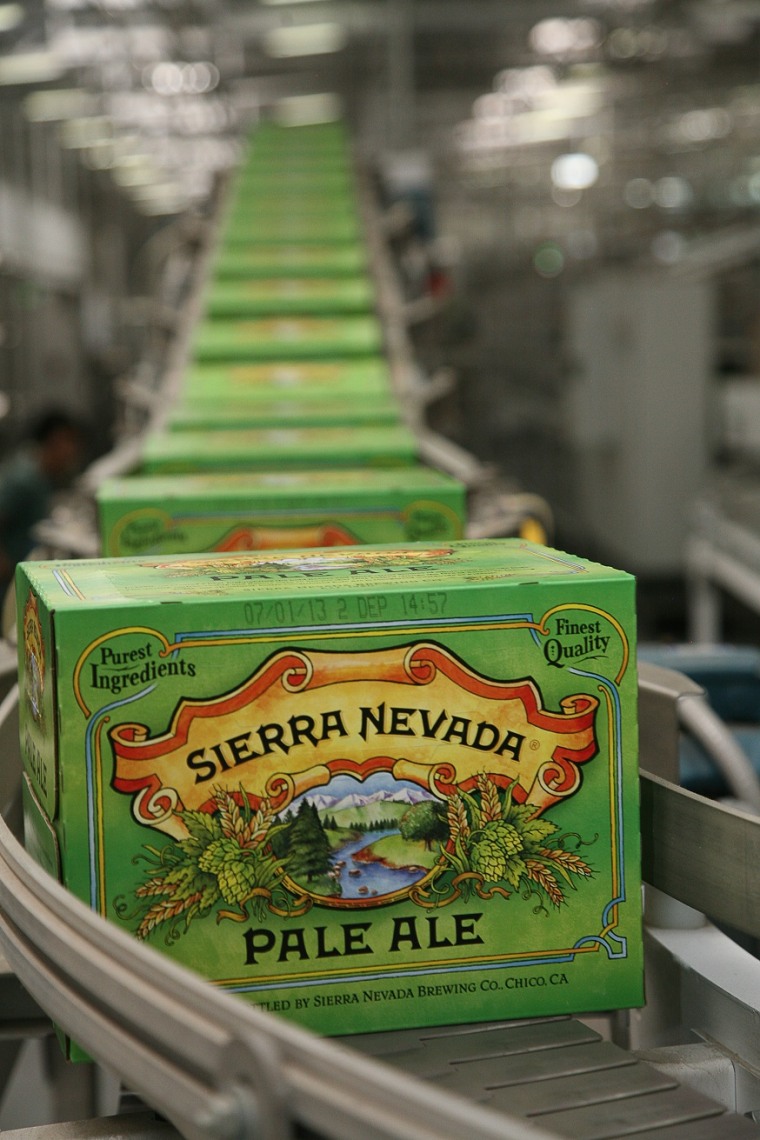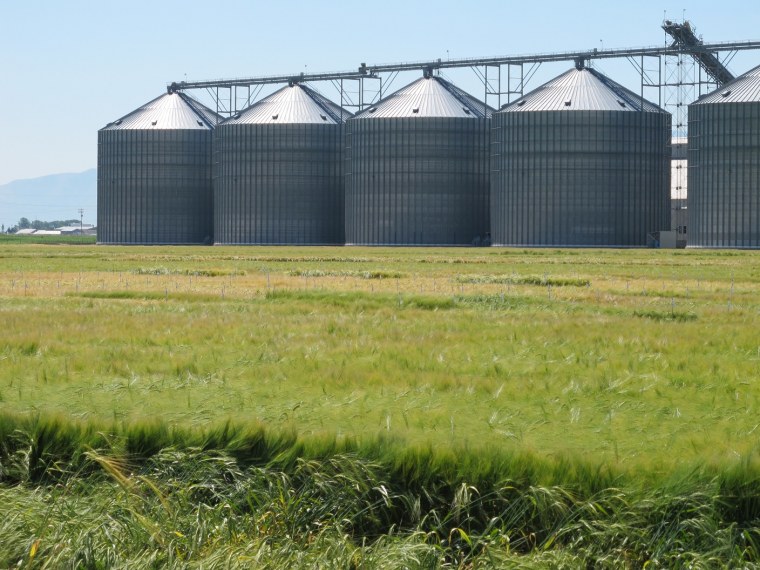As water becomes increasingly scarce on our ever more crowded and warming planet, brewers of beer are racing to secure a steady supply of their most prized ingredient by using less of it.
"Without water, there is no beer," Kim Marotta, the sustainability director for MillerCoors, the Chicago-based joint venture of international brewing giants SABMiller and Molson Coors, told NBC News.
Like many in the brewing industry, MillerCoors understands that access to water of the quantity and quality it needs to grow barley and hops and brew beer is no longer a guarantee as population growth, water pollution and climate change threaten water resources.
The United Nations projects that by 2030 nearly half of the world's population could face a scarcity of water, with demand outstripping supply by 40 percent.
MillerCoors is one of several dozen corporate heavyweights that endorse the United Nations' CEO Water Mandate, a public-private initiative to assist companies in the development, implementation and disclosure of water sustainability practices.
"We need to make sure that in the places where we have breweries or the places that we are growing our barley, that water is available so that we can have a sustainable business well into the future," Marotta said.
Similar water conservation efforts are underway at other breweries that endorse the United Nations' mandate, including Anheuser-Busch InBev, the world's largest brewer by volume whose brands include Budweiser and Stella Artois, and Diageo, the brewer of Guinness.
Saving suds by saving water
In 2008, MillerCoors set a goal of reducing by 15 percent the amount of water it uses to brew a barrel of beer. At the time, the ratio was 4.1 to 1. That number has dropped to 3.82 to 1, according to figures the company released Tuesday in its annual sustainability report, which covers 2012.
"We continue to make a lot of progress in that area," Marotta said. In fact, 2013 year-to-date, MillerCoors' water-to-beer ratio is 3.51 to 1 across its eight U.S. breweries; two in July were below 3 to 1, she noted.

While comparing water use per barrel of beer produced among different breweries is difficult given the differences in equipment, brewing styles, and non-brewing uses of water, the average is somewhere between 5 and 7 to 1, according to industry experts.
The bulk of MillerCoors' water savings has come from changes in human behavior, such as brewery workers turning off hoses that were previously constantly running and carefully managing the flow of water through the brewery to optimize its usage, Marotta explained.
The company also invests in technology such as water reclaiming systems to reuse water for non-brewing purposes.
Crafty conservation agenda
Meanwhile, nearly two dozen craft brewers in the U.S. are signatories to an initiative spearheaded by the Natural Resources Defense Council, an environmental group, to toughen enforcement of the Clean Water Act.
The push is required, the council said, because protections for headwater streams and wetlands, which are deemed critical for providing reliable and clean water supplies, are in legal limbo awaiting clarification on enforcement guidelines from the administration of President Obama, who is a home brewer.
"As local business owners who happen to produce beers with a rabid following, craft brewers bring a strong voice and an unmatched understanding of water to these debates," Karen Hobbs, a senior policy analyst for the council and manager of the Brewers for Clean Water campaign, told NBC News via email.

Among those who signed on to the clean water initiative is Sierra Nevada Brewing Co., a Chico, Calif., based brewery that is a pioneer in sustainability initiatives, including water conservation.
"Without access to clean and abundant water, you can't make beer," Cheri Chastain, the sustainability coordinator at Sierra Nevada, told NBC News. "I think the whole brewing industry realizes that."
Similar to MillerCoors, the California craft brewer has ambitious water conservation goals, aiming to hit a water-used-to-beer-produced ratio of 4-to-1 by the end of 2013. Among steps taken there include switching out soapy water for a silicon-based lubricant on the bottling line.
"There used to just be this stream of soapy liquid coming off the conveyors and there is probably at least a mile of conveyor in there," Chastain explained. "That is water we are not using and it saves a couple million gallons a year."
Water on the farm
Saving water inside the brewery pales in comparison to what's possible on the farm, which previous analyses have indicated account for about 90 percent of beer's total water footprint.
With farmland included, for example, MillerCoors' parent SABMiller found in a 2009 analysis that 115 liters of water are required for every liter of beer produced in South Africa. In the Czech Republic, where the company's Pilsner Urquell is brewed, the ratio was 45 to 1.
While figures for U.S. operations are unavailable, Marotta said agriculture in this country too accounts for about 90 percent of beer's total water footprint. To that end, in 2011 the company established an experimental barley farm in southern Idaho to explore water-saving techniques.
For example, so-called end guns at the tip of two circular irrigation pivots that aim water towards the hard-to-reach corners of square plots were turned off, saving 5 million gallons of water in a year. Most of the barley from the corners when the end guns were on was unsuitable for beer, Marotta noted.
Other on-the-farm measures include replacing damaged sprinklers on the pivots, lowering the pivots closer to the ground and installing GPS and other sensors that allow farmers to moderate the flow of water to match the needs of the underlying soils.
"All told, we saved 270 million gallons of water (in 2011 and 2012), which, to bring it back to the breweries, is what we use in one brewery in two months," Marotta said.
MillerCoors is now expanding the water conservation practices to its barley growers in water-stressed regions of Montana, Wyoming, and Colorado.
In the San Luis valley of Colorado, for example, the aquifer that MillerCoors' barley growers depend on "is depleted" due to a five-year drought in the area, Marotta said. "We are looking at really immediate concerns there."
Keeping the water pressure on
The Natural Resources Defense Council aims to keep pushing a clean water agenda for brewers long after the dust settles from the current political battle surrounding the Clean Water Act.
"We are all in it for the long haul," Hobbs, the Brewers for Clean Water campaign manager, said. "We have to be given the scary stuff on the horizon if we don't keep vigilant on water issues in the face of climate change and pollution fights."
That commitment appears reflected in the hiring plans at craft breweries, according to Sierra Nevada's Chastain, who noted that sustainability coordinator positions such as hers are popping up around the country. The jobs, she said, reflect acknowledgement that sustainability can save brewers money.
But water conservation, she added, is "a tough nut because, as a country, we don't pay enough for our water. It is relatively cheap compared to other natural resources … But it is the No. 1 ingredient in our beer, in all beer, so using it respectfully and responsibly is a subtle but underlying motivator."
John Roach is a contributing writer for NBC News. To learn more about him, visit his website.
